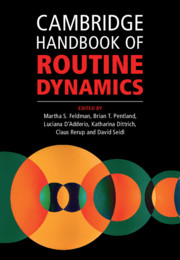Book contents
- Cambridge Handbook of Routine Dynamics
- Cambridge Handbook of Routine Dynamics
- Copyright page
- Contents
- Figures
- Tables
- Contributors
- Preface
- Chapter 1 What Is Routine Dynamics?
- Part I Theoretical Resources for Routine Dynamics Research
- Part II Methodological Issues in Routine Dynamics Research
- Chapter 8 Ethnography and Routine Dynamics
- Chapter 9 Video Methods and Routine Dynamics
- Chapter 10 Field Experiments and Routine Dynamics
- Chapter 11 Agent-Based Modelling in Routine Dynamics
- Chapter 12 Sequence Analysis in Routine Dynamics
- Chapter 13 Narrative Networks in Routine Dynamics
- Chapter 14 Bakhtin’s Chronotope and Routine Dynamics
- Part III Themes in Routine Dynamics Research
- Part IV Related Communities of Thought
- Author Index
- Subject Index
- References
Chapter 13 - Narrative Networks in Routine Dynamics
from Part II - Methodological Issues in Routine Dynamics Research
Published online by Cambridge University Press: 11 December 2021
- Cambridge Handbook of Routine Dynamics
- Cambridge Handbook of Routine Dynamics
- Copyright page
- Contents
- Figures
- Tables
- Contributors
- Preface
- Chapter 1 What Is Routine Dynamics?
- Part I Theoretical Resources for Routine Dynamics Research
- Part II Methodological Issues in Routine Dynamics Research
- Chapter 8 Ethnography and Routine Dynamics
- Chapter 9 Video Methods and Routine Dynamics
- Chapter 10 Field Experiments and Routine Dynamics
- Chapter 11 Agent-Based Modelling in Routine Dynamics
- Chapter 12 Sequence Analysis in Routine Dynamics
- Chapter 13 Narrative Networks in Routine Dynamics
- Chapter 14 Bakhtin’s Chronotope and Routine Dynamics
- Part III Themes in Routine Dynamics Research
- Part IV Related Communities of Thought
- Author Index
- Subject Index
- References
Summary
Narrative networks provide a way to summarize the "pattern-in-variety" that is typical of organizational routines. Unlike social networks, the nodes in a narrative network represent actions or events. By formalizing action patterns as networks, narrative networks provide a foundation for visualizing and analysing stability and change in routines.
- Type
- Chapter
- Information
- Cambridge Handbook of Routine Dynamics , pp. 184 - 195Publisher: Cambridge University PressPrint publication year: 2021
References
- 2
- Cited by



